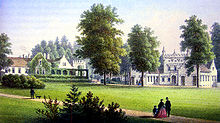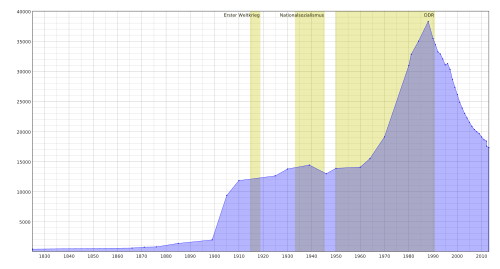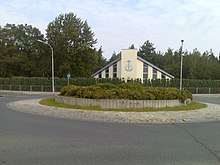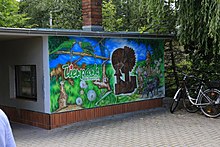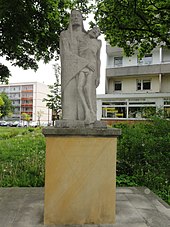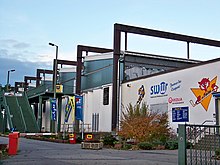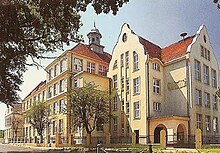Weißwasser / Upper Lusatia
| coat of arms | Germany map | |
|---|---|---|
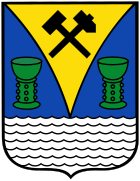
|
Coordinates: 51 ° 30 ' N , 14 ° 38' E |
|
| Basic data | ||
| State : | Saxony | |
| County : | Goerlitz | |
| Management Community : | Weißwasser / OL | |
| Height : | 140 m above sea level NHN | |
| Area : | 63.42 km 2 | |
| Residents: | 15,886 (Dec. 31, 2019) | |
| Population density : | 250 inhabitants per km 2 | |
| Postal code : | 02943 | |
| Area code : | 03576 | |
| License plate : | GR, LÖB, NOL, NY, WSW, ZI | |
| Community key : | 14 6 26 600 | |
City administration address : |
Marketplace 02943 Weißwasser / OL |
|
| Website : | ||
| Lord Mayor : | Torsten Pötzsch (Voters' Association Klartext) | |
| Location of the city of Weißwasser / Oberlausitz in the district of Görlitz | ||
Weißwasser / Oberlausitz (in the official municipality register Weißwasser / OL ), Upper Sorbian , is a large district town in the northeast of Saxony and the third largest city in the Görlitz district and the eighth largest in Upper Lusatia and is located in the middle of a lignite-rich heathland between the Lusatian lake district and the German-Polish border.
With its rise from a rural heath village to an industrial town, Weißwasser grew from a good 1000 (1885) to over 38,000 inhabitants in 1988 and then fell back to 16,000 in 2020. This means that Weißwasser is now a small town again .
Weißwasser belongs to the official Sorbian settlement area in Saxony.
geography
Geographical location
The city is nestled between the Muskau Arch in the north, the Muskau Heath in the northeast and the Nochten open-cast mine in the southwest. The urban area is enclosed by extensive forest areas, which are dominated by pine and oak. The northern forests are interrupted by extensive pond areas , from the Braunsteich in the east to the Halbendorfer See in the northwest. The Struga rises in Weißwasser and flows in the west along the Berlin – Görlitz railway into the Schleifer region . The Nochten open-cast mine has reached the southern outskirts and will also be approaching the Schleifer region by the middle of the next decade.
Neighboring communities
Bordering on the urban area of Weißwasser (clockwise) are the communities Trebendorf (NW), Groß Düben (N), Gablenz (NE), Krauschwitz (O), Weißkeißel (SO; forms the administrative community Weißwasser / OL ) and Boxberg / OL ( with Weißwasser ) ( S). The Tzschelln district is located south of the actual urban area . This strip of land, lying between the municipalities of Trebendorf and Boxberg and penetrated by the opencast mine, borders the municipality of Spreetal in the southwest . The town of Bad Muskau is located around 8 km to the northeast , and has been the power center of the region for centuries.
The nearest medium- sized towns are Spremberg (Grodk; about 20 km northwest), Forst (Lausitz) (Baršć; 35 km north), Hoyerswerda (Wojerecy; 35 km west), Żary (Sorau; 45 km northeast), Bautzen (Budyšin; 50 km southwest) and Görlitz and Zgorzelec (55 km south). The nearest large cities are Cottbus (Chóśebuz; 50 km north), Zielona Góra (Grünberg; 90 km northeast), Dresden (Drježdźany; 100 km southwest), Liberec (Reichenberg; 110 km south) and Legnica (Liegnitz; 130 km east).
climate
White water has a cool, moderate continental climate . With 625 mm annual precipitation (mean for the years 1961–1990), the city is below the German mean of 700 mm.
history

On June 8, 1552 , Weißwasser was first mentioned in the register of possessions of the Muskau registry. The first cartographic recording of Weißwasser in a map of Upper Lusatia is dated to 1593. The original village of Weißwasser was in the western part of today's city, around August-Bebel-Strasse . This area of the city is now called the "Old Village". In 1772 the first school was founded in Weißwasser and in 1817 the first certified teacher came to Weißwasser. Lignite mining began in 1860. The first brick factory was built around the same time. From 1815 to 1945 Weißwasser belonged to Silesia .
By the Berlin-Görlitz railway company , which in the years 1866/1867 Berlin-Görlitz railway built, White Water received a railway station. Together with the clay, quartz sand, wood and coal deposits in the area, this favored the further development of the area, so that Weißwasser became known as a place for glassmaking in the 19th and 20th centuries . During the founding period , eleven glassworks , five glass refineries , three brickworks and a few coal works were built in Weißwasser . These companies not only shaped the townscape and the working class - around 75 percent of the residents of Weißwasser worked in or for the glass industry - they also ensured that Weißwasser rose to become the European center of glass production at the turn of the century. From window glass to cut crystal glass , the entire product spectrum was covered. The production of glass bulbs by the United Lausitzer Glaswerke for incandescent lamps , especially for AEG and its participation Osram , achieved great economic importance. VLG's consumer goods division was one of the few design-oriented companies in the early 20th century.
Weißwasser is surrounded by large, contiguous forest areas with a high proportion of pine trees. Numerous forest fires started in these areas, some of them considerable. White water itself was partially destroyed as a result. In order to be able to prevent the widespread spread of forest fires, a system should be developed which would allow the forests to be monitored permanently and, if necessary, to sound the alarm. This was invented by forester Walter Seitz (1863–1944) in the Muskau Forest south of Weißwasser. Between 1890 and 1900, a wooden tower, approx. 12 to 18 meters high, was built on a hill on the Grüner Weg , which was occupied when there was a high risk of forest fires. From this tower a line of sight was cut into the forest as far as the former Vorwerk (Dominium Weißwasser) in order to give the residents the opportunity to receive the light signals transmitted by the fire guard. In order to be able to localize the place of fire in the large forest massif more precisely, squares, also known as hunting, were created in the forests by Seiz. Thus, approx. 45 hectares of forest with the corresponding number were created. When a forest fire was sighted, the exact location of the fire location could be transmitted with the help of the light signals and rapid fire fighting could be started. Seitz received the German imperial patent for the world's first fire watchtower in 1902 . He presented this invention in 1904 at the world exhibition in St. Louis . At the site of the first fire watch tower, there was an almost 30 meter high concrete tower until 2009, which had to give way to the expanding Nochten opencast mine .
A small railway line through Weißwasser was built in 1897 to improve the development of raw materials . Even before the south-eastern village of Hermannsdorf was incorporated (1903), the village of Weißwasser was larger than the nearby town of Muskau . The village of Weißwasser continued to grow and industry settled. This increased the number of inhabitants and the number of school-age children. On the initiative of the headmaster at the time, a new school building was built in Weißwasser in 1912 (today School 1 ). A church was built for workers who moved from Catholic regions to Weißwasser. On August 28, 1935, Weißwasser received city rights .
Towards the end of the Second World War from June 1944 to February 1945 there was a satellite camp of the Groß-Rosen concentration camp in the city at Neuteichweg 44 , in which around 300 Jewish women had to do forced labor as concentration camp prisoners for the Valvo tube works . Upon dissolution of the camp they were on 24 February 1945, the death march to the satellite camp Horneburg of Neuengamme sent. In the last weeks of the war the Red Army reached Weißwasser. The destruction of the railway bridge by German troops was only a short-term obstacle. After the liberation on April 19, 1945, around 40% of the city was destroyed. Glass production resumed five months later.
During the GDR era in 1951, the Association of People's Own Enterprises (VVB) Ostglas and the head office of VVB Glas / Ceramics Berlin built and operated the pioneer holiday camp “Tent Camp of Friendship” on Braunsteich .
The nearby hunting lodge near Mühlrose , which the poet Heinrich Laube visited during his imprisonment in 1840, was demolished in 1972 due to increasing deterioration. Two years before it was completely devastated for the Nochten opencast mine, the village of Tzschelln was incorporated into Weißwasser in 1977.
After referendums, in 1990 the district councils of the districts of Weißwasser and Hoyerswerda applied for incorporation into the Free State of Saxony, so that Weißwasser became a Saxon town again. In the city itself there was approval of 77.2 percent.
From 1952 to 1994, Weißwasser was the seat of the Weißwasser district of the same name . In the debate about the district seat for the Lower Silesian Upper Lusatia District , created in 1994 , the city was unable to prevail against Görlitz and Niesky due to its location in the district. Since April 1, 1997, Weißwasser has the status of the major district town .
Due to National Socialism, there is no Jewish community in Weißwasser. Joseph Schweig , one of the most important people in the development of Weißwasser towards the end of the 19th century, belonged to Judaism and in 1902 founded a Jewish burial site that lasted until 1978. An honorary burial site for the Schweig family was rebuilt in 2010 on the site of the Jewish cemetery, which was leveled in 1982.
Population development
In the early years of the GDR, the city experienced not only the glass factories, but also the newly built Boxberg power plant and smaller industrial companies, an upswing that led to steady population growth, so that at the end of the 1980s the city reached a peak of almost 39,000 inhabitants, three times as much big as it was 30 years ago. From the 1960s onwards, the Weisswasser-Süd residential area was built to the southwest of the original city location and consists mainly of prefabricated buildings .
After the political change in the GDR , most glass and industrial companies had to close, and other companies had to cut jobs in order to be able to survive economically in the changed political system. The high unemployment rate of over 20% and the urban exodus developed into major problems - within the next two decades the number of inhabitants has more than halved, resulting in large-scale housing demolitions. Unlike many other district towns, Weißwasser could not incorporate any places in the surrounding area to compensate for the population decline. Forecasts assume a further decline in the population to around 15,400 inhabitants in 2025. Weißwasser has the worst development prospects of all Saxon municipalities between 15,000 and 25,000 inhabitants by 2020.
Furthermore, there is an increase in the average age of the population due to the emigration of young parts of the population.
The population decline showed its effects especially in Weißwasser-Süd. While the Südpassage, a shopping center in the middle of a residential area in the southern part of the city, was built in the early 1990s , around 15 years later it formed almost the edge of the built-up area and was finally outside the urban residential areas 20 years after the fall of the Wall.
|
|
|
|
|
|
Sources: weisswasser.de, Digitales Historisches Ortsverzeichnis von Sachsen, from 1990 (always on December 31st) State Statistical Office of the Free State of Saxony, Lausitzer Rundschau On the basis of the 2011 census , the (calculated) official population for December 31, 2012 was revised downwards by the State Statistical Office by 818 from 18,359 to 17,541 inhabitants. The figure is around 4.5% lower than originally reported. |
||||
politics
City council
2014
After the municipal council election on May 25, 2014 , the 22 seats of the city council were distributed among the individual groups as follows:
- CLEAR TEXT (KT): 6 seats
- CDU : 6 seats
- LEFT : 4 seats
- WE FOR HIER eV (WFH): 2 seats
- SPD : 2 seats
- Community of voters for children, youth and family (KJiK): 1 seat
- NPD : 1 seat
2019
Since the municipal council election on May 26, 2019 , the seats of the city council have been distributed among the individual groups as follows.
- CLEAR TEXT (KT): 7 seats
- AfD : 5 seats
- CDU : 3 seats
- LEFT : 2 seats
- SPD : 2 seats
- For Unser Weißwasser (FUW): 1 seat
- Community of voters for children, youth and family (KJiK): 1 seat
The initiative “For our white water” received 8.3% so many votes that it could send two representatives to the city council. However, she only set up the single candidate Karina Ott, so that only 21 seats are awarded in the current city council.
Mayor (incomplete)
Community leader
- around 1886 to 1888 August Neugebauer
- 1888 to 1896 Hermann Kiesewetter
- December 7th, 1898, Karl Gierth, first full-time community leader
- 1901, Dr. jur. Höpker (acting)
- May 1, 1902 to summer 1914, Otto Rummert, first mayor of Weißwasser
- Summer 1914 Joseph Schweig - October 15, 1916, acting mayor as 1st lay judge
- October 16, 1914 to March 31, 1933, Otto Lange
- April 1, 1933 to March 31, 1934, Fritz Boehm (First Alderman and Chief Justice Secretary) (acting)
- April 1, 1934 to August 13, 1934, Dr. Gerhard Weyh
- August 14, 1934 to March 31, 1935, Paul Petow (acting)
mayor
(Title from April 1, 1935)
- April 1, 1935 to December 14, 1935, Paul Petow (acting)
- December 15, 1935 to April 17, 1945, Karl Wenderoth (with interruption 1942/43 and representation by Petow)
- April 24, 1945 to 1946, Karl Ingelöf
- until early 1947, Paul Bistrosch
- from the beginning of 1947 to the end of 1947, Kurt Schildan
- Early 1948 to March 21, 1951, Georg Teubner
- March 21, 1951 to October 20, 1952, Heinz Krüger
- from October 21, 1952, Willy Dörner
- around 1959 to at least 1968, Horst Dreihardt
- around 1977 until at least May 1986, Otto Bräsigk
Lord Mayor since 1990
- Dieter Loessner (CDU), 1990-2001
- Helma Orosz (CDU), 2001–2003, then Saxon State Minister for Social Affairs , 2008–2015 Mayor of Dresden
- Hartwig Rauh (independent), 2003-2010
- Torsten Pötzsch (plain text), since 2010
coat of arms
As early as February 28, 1914, the community council issued a tender for the design of a community coat of arms for a fee of 20 marks. Since the submitted proposals did not meet with approval, they turned to the magazine Der Herold to commission drafts. Only at the third attempt did a conception find approval in the Council. The coat of arms was designed by Privy Councilor Hildebrand and approved by the Prussian State Ministry on January 31, 1927. Blue and yellow , the colors of Upper Lusatia , form the basis. On each side there is a green glass beaker on a blue background, symbolizing the local glass industry. Weißwasser was the world's largest glass-producing place in the 1920s. There are also 18 small bumps on the beakers, which symbolize the most important glass workshops of the time, eleven glass manufacturers and seven processing companies. Mallets and iron on a yellow background indicate lignite mining near the city limits. Seven white waves are shown in the base of the shield, referring to the seven former heather lakes of the Weißwasser district. The clear lakes inside and outside the municipality also form the origin of the place name.
With the green cups on a blue background, Hildebrand had heraldically incorrectly designed the coat of arms . The cups should have been one of the two metals on a colored background, for example silver as shown on the left in the lower coat of arms. It is said to have been a heraldist's quirk not to fully follow the rules of the coat of arms. At the same time, it should be his only coat of arms that was approved. It can be assumed that Prof. Hildebrand knowingly disregarded the heraldic rules because he wanted to represent the glass production in white water in the coat of arms. Therefore, the cups should not represent pomp and wealth in gold or silver, but bottle-green glass goblets from local production.
Town twinning
Weißwasser has partnerships with Brühl in North Rhine-Westphalia and Żary (Sorau) in the Polish Lebus voivodeship. Both partnerships arose at the time of transition between the cities of about the same size at the time. The town twinning between Brühl and Weißwasser was signed on October 3rd, 1990, on the day of German reunification . The long-standing friendship with Żary was sealed in June 1997 with a partnership agreement. During the inauguration of Sorauer Platz on August 30, 2007, which was attended by the mayor and city council chairman Żarys, the longstanding friendship between the two cities was highlighted.
Culture and sights
Sights in Weißwasser and its surrounding area include:
- Tower on Schweren Berg , 30 m high observation tower on the edge of the Nochten opencast mine
- Rhododendron Park Kromlau with Rakotzbrücke
- Brown pond
- Bronze sculpture Die Kesse , Gutenbergstrasse
- Grove of honor for the victims of fascism, at the cemetery
- Energy stele in front of the swimming pool
- Memorial stone at the branch of the Groß-Rosen concentration camp , Kromlauer Weg / Neuteichweg
- Fürst-Pückler-Park Bad Muskau
- Glasmacherbrunnen in front of the train station
- Glassmaker's monument in front of the former glass school, Jahnstrasse
- Weißwasser Glass Museum , Forster Strasse
- Jungfernbrunnen in front of the Stadtwerke Weißwasser building on the Street of Peace
- Nochten boulder park
- Schillerbank, Bautzener Strasse / Rosa-Luxemburg-Strasse
- Sportsman Memorial at the Puck, Lutherstrasse
- Weißwasser Zoo
- Muskau Forest Railway
- Water tower at the swimming pool, the landmark of Weißwasser
Several buildings in Weißwasser were designed by the Bauhaus architect Ernst Neufert , who was the in-house architect of the United Lusatian Glass Works from 1934 to 1944 . Underneath is the former 6-storey warehouse building of the group (the later former wholesale organization VEB Obst, Gemüse und Tischkartoffeln (GHG) ) and the villa of the director of the VLG group Dr. Bruno Kindt in what is now Rosa-Luxemburg-Strasse.
Memorials
- A sandstone sculpture from 1947 by Gustav Seitz on Muskauer Strasse commemorates the victims of the concentration camp system from 1933 to 1945.
- The memorial plaque on the corner house at Mittelstrasse 1 / Muskauer Strasse commemorates a Polish Jew who was driven through the city with thousands of other women on a death march from the Neusalz subcamp ( Freystadt i. Niederschles. ) Of the Groß-Rosen concentration camp to Bavaria in February 1945 and was shot by SS men . Alone on the road between Bad Muskau, Krauschwitz and Weißwasser, they murdered many of the prisoner women and buried them. Only 60 survived the march.
- A grove of honor by the sculptor Burscheck in the cemetery behind the Soviet memorial has been commemorating the victims of fascism from the then Weißwasser district since 1974 .
Parks
In white water and parks exist: the largest park is the Amusement Park in the south of the city with a large festival grounds, skating rink , BMX -Crossbahn, inline hockey -Spielfeld, soccer field and several playgrounds. There are smaller parks at the cemetery and in the Jahnpark on the Jahnteich. The Luther Park in the north of the city was almost completely converted into an allotment garden after the Second World War.
Sports
There are 33 registered sports clubs in Weißwasser, in which 28 different sports are practiced. The city maintains three school sports halls, including a three-field hall with spectator seats and two sports halls, including a two-field hall. Every year around € 150,000 is used for indirect sports promotion measures (e.g. management costs without investments in the municipal sports infrastructure).
Ice hockey has been played in sports clubs in Weißwasser since 1932 . The local ice hockey club Eissport Weißwasser "Lausitzer Füchse" was particularly successful. As SG Dynamo Weißwasser it was the most frequent German champion in the GDR league . Their home stadium was the 15,500-seat Wilhelm-Pieck-Kunsteisstadion . In addition to this open-air stadium, the ice rink (Fuchsbau) was later built. Following the demolition of the artificial ice stadium, the Weißwasser ice arena was built here and, after a year and a half of construction, opened in September 2013 with 3050 seats. The old ice rink was then torn down.
The city's largest football club is VfB Weißwasser , which plays its home games in the Turnerheim sports complex .
The Jahnbad as an outdoor pool and the municipal swimming pool are available for swimming. In addition, there are a large number of bathing lakes in and around Weißwasser, of which the Halbendorfer See has gained national fame. In the neighboring town of Krauschwitz there is the leisure pool Erlebniswelt Krauschwitz .
In 2012, Weißwasser took part in the nationwide Mission Olympic city competition to promote popular sports. In this context, the city was able to set a new Guinness record with a 4866.5-meter-long bucket chain and, together with Meiningen, was named Germany's sportiest city in 2012.
Economy and Infrastructure
traffic
Streets and squares in Weißwasser
Street
The distance to the northeastern border crossing to Poland in Bad Muskau is 7 km. The next motorway junction to the A 15 - Roggosen - is 34 km to the north. The federal highway 156 running through Weißwasser leads in a southerly direction past the Boxberg power station to Bautzen to the A4 , which is approx. 49 km away from the town center. In a north-easterly direction, the B 156 leads to Krauschwitz on the B 115 , the second important north-south connection in the northern district.
rail
Weißwasser is on the Berlin – Görlitz railway line , which is single-track and not electrified in this section, and can be reached by regional train every hour without changing trains from Cottbus and Spremberg (north) and Zittau and Görlitz (south). The Ostdeutsche Eisenbahn GmbH (ODEG) operates this under the line number RB65.
It was previously planned to build a rail link between Bautzen and Weißwasser. A project that was discussed for decades and never realized. Today the railway lines Weißwasser – Forst and Weißwasser – Bad Muskau have been closed and mostly dismantled .
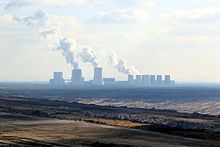
Muskau Forest Railway
From the Weißwasser-Teichstraße station, the small train (600 mm gauge) of the Muskau Forest Railway to Kromlau and Bad Muskau is operated as a museum railway with passenger services. Apart from these two routes, only a part of the former clay railway remains of the large route network. Its route leads from Teichstrasse train station west around the city, crosses under the bridge of the disused railway line Weißwasser – Forst , changes direction and crosses the railway line Berlin – Görlitz over a bridge and leads between Trebendorf and Weißwasser to the Nochten opencast mine . Until the mining interruption, the route ended at a clay pit in the zoo between Trebendorf and Mühlrose , the new replacement building, inaugurated in 2017, leads the route along the edge of the open pit to the southern edge of the city to the tower on Schweren Berg .
air traffic
The closest airport with an asphalt track is the Rothenburg / Görlitz airfield about 30 km southwest.
The nearest larger airports are Dresden Airport (approx. 110 km) and Leipzig / Halle Airport (approx. 190 km) in the west, the Berlin airports (approx. 150 km and 180 km respectively) in the north, the Nikolaus-Kopernikus- Wrocław Airport (approx. 170 km) in the east and Václav Havel Airport in Prague (approx. 160 km) in the south.
Economic history
From 1873 to 1904, eleven glassworks, five glass refineries and, as a service provider for the glassworks, numerous machine and glass mold factories were built in Weißwasser:
- Glasfabrik Zwahr, Neubauer & Co. Weißwasser, founded in 1872 (from 1877 Glaswerke Gelsdorf, Neubauer & Co. Weißwasser)
- Glashüttenwerke Hirsch, Janke & Co. Weißwasser, founded in 1884
- Upper Lusatian Glassworks Josef Schweig & Co., founded in 1889 (Aktienhütte)
- Glashüttenwerke Germania Schweig, Müller & Co. Weißwasser, founded in 1894
- Lusatian sheet glass factory Thormann & Maschke, Weißwasser, founded in 1894 (from 1907 glass factory Dr. Martin Schweig)
- Glassworks Hirsch, Janke & Co. Malky, Müller & Co. department, founded in 1897 (Bärenhütte)
- Ladiges, Greiner & Co. “Luisenhütte” glassworks, founded in 1897
- Glassworks "Union" Menke, Mudra & Co. KG, founded in 1897
- Gelsdorf, Grimm & Co. Glashüttenwerk GmbH Weißwasser, founded in 1898
- Neue Oberlausitzer Glashüttenwerke J. Schweig & Co. GmbH, founded in 1899
- Opalescence-, Cathetral- and Ornamentglaswerke GmbH, founded in 1903
- Glassworks Grabner & Berger, founded in 1899 (from 1907 Lausitzer Schockspiegelfabrik GmbH)
- United Lausitzer Glaswerke AG (VLG) with the glass designer Wilhelm Wagenfeld
- Schlesische Glasmanufaktur Menke & Co., from 1919 Schlesische Glasmanufaktur Lustig & Co.
- Glass mold factory Herta Nippraschk GmbH Weißwasser, Görlitzer Str. 19
After 1945 these were
- VEB Oberlausitzer Glaswerk
- VEB special glass factory "unit"
- VEB Glaswerk "Bärenhütte"
- VEB "Neuglas" and
- VEB color glass factory white water,
later combined in the "Lausitzer Glas" combine.
There are currently two glass companies
- Stölzle Lausitz GmbH (formerly Oberlausitzer Glaswerke)
- Telux Glasproducts & Components GmbH (formerly "Einheit" special glass factory)
Since the turn of the century, near-surface coal mines have been opened up in the entire area around Weißwasser for the operation and development of the glass-producing companies.
The city and the entire region are facing a major structural change due to the planned phase-out of coal production and combustion.
Established businesses
The corporate structure in Weißwasser has been characterized by medium-sized companies and retailers since the fall of the Wall. The LEAG is the Boxberg power plant and the mines Nochten and Reichwalde one of the largest employers in the region. The glass industry that flourished in the 20th century - probably the largest in Germany - has almost completely disappeared. The Willms meat processing with 350 employees processed 1,600 tons of meat a month. The Schnitter brewery ceased operations in 1991.

media
On September 13, 1903, the first edition of the daily newspaper “Latest news for Weißwasser and surroundings” appeared in Weißwasser. Local editions of the daily newspapers Lausitzer Rundschau and Sächsische Zeitung as well as the advertising newspaper WochenKurier are currently appearing in Weißwasser . Radio WSW GmbH produces a radio station and a television program in Weißwasser-Süd .
The “Weißwasseraner Anzeiger” has been published as an online edition since 2007.
Public facilities
- Weißwasser District Hospital (190 beds) together with the houses in Ebersbach and Zittau as part of the district's own hospitals
- Weißwasser City Library
The establishment of the branch office of the Federal Office of Economics and Export Control (BAFA) in Weißwasser should be completed by March 2020 .
education
Due to the decline in the birth rate from the mid-1980s and the decline in population since the fall of the Wall , the number of pupils in Weißwasser in 2008 was more than half below that of 1990. As a result, several elementary and secondary schools and the municipal high school were closed. Most recently, the number of primary schools was reduced to three after a new gymnasium was built on the site of the 1st primary school, which accepted the additional students.
The following schools are located in Weißwasser:
- Pestalozzi primary school in Weißwasser and 2 other primary schools
- Bruno Bürgel High School (middle school until 2013)
- Landau- Weißwasser High School
- Vocational School Centre
- Brothers Grimm School, school to promote learning
- Astrid Lindgren School, special school for the mentally handicapped
- Hans Fallada School, school for educational assistance
- Community College
Non-formal educational institutions:
Personalities
sons and daughters of the town
sorted by year of birth
- Reinhold Greiner (1903-1941), communist and anti-fascist, joined in the Spanish Civil War, the International Brigades to
- Gerhard Froboess (1906–1976), composer, master sound engineer and publisher
- Adolf Schönke (1908–1953), legal scholar
- Rudolf Lange (1910–1945), National Socialist SD commander, participant in the Wannsee Conference
- Horst Klassenbach (1925–2001), tattoo artist
- Kurt Stürmer (1926–2009), ice hockey player, national player of the GDR
- Günter Schubert (1938–2008), actor
- Wolfgang Wünsche (1938–2018), ice hockey player and coach
- Hans Jürgen Wenzel (1939–2009), composer and conductor
- Klaus Hirche (* 1939), ice hockey goalkeeper and coach, national player of the GDR, Olympic participant in 1968
- Dieter Pürschel (* 1941), ice hockey goalkeeper , national player of the GDR, Olympic participant in 1968
- Bernd Poindl (* 1941), ice hockey player, national player of the GDR, Olympic participant in 1968
- Hartmut Nickel (1944–2019), ice hockey player
- Roland Hemmo (* 1946), voice actor and actor
- Horst Meinhardt (* 1948 or 1949), speed skater and athletic trainer
- Peter Escher (* 1954), television and radio presenter and journalist
- Robert Reiss (* 1955), football player
- Christa Luding-Rothenburger (* 1959), speed skater and cyclist
- Hagen Wellschmidt (* 1960), soccer player
- Angela Ranft (* 1969), racing cyclist
- Jens Harder (* 1970), comic book artist and illustrator
- Alexander Greiner (* 1972), television presenter
- Mirko Lüdemann (* 1973), ice hockey player
- Stefan Mann (* 1975), ice hockey player
- Tino Chrupalla (* 1975), politician (AfD)
- Robert Hoffmann (* 1977), ice hockey player
- Lars Müller (* 1977), ice hockey player
Other personalities with a connection to the city
- Joseph Schweig (1850–1923), German merchant of the Jewish faith, operator of several glassworks, since 2006 honorary citizen of Weißwasser
- Dorothea von Philipsborn (1894–1971), sculptor
- Wilhelm Wagenfeld (1900–1990), product designer in the United Lausitz Glass Works, since 2016 honorary citizen of Weißwasser
- Konrad Tag (1903–1954), glass artist and engraver
- Friedrich Bundtzen (1910–1989), glass designer
Others
From August 9, 1956 to February 10, 1973 there was a GDR navy mine clearing boat called "Weisswasser" , which looked for mines from the Second World War on the Baltic Sea coast and in the bay.
literature
- Herbert Tschätsch: From TSV to EHC: Ice hockey story (s) from Weißwasser . Niederlausitzer Verlag, Guben 2006, ISBN 978-3-935881-37-1 .
- Friends of the Weißwasser Glass Museum (ed.): Glassworks in Weißwasser . Sutton, Erfurt 2005, ISBN 3-89702-771-2 .
- From the Muskauer Heide to the Rotstein. Home book of the Lower Silesian Upper Lusatia District. Lusatia Verlag, Bautzen 2006, ISBN 978-3-929091-96-0 , p. 229 ff .
- Dr. E. Merkle (Ed.): Chronicle of Weißwasser. 444 years of history and stories . Inter Media Advertising Agency GmbH, Weißwasser 1996.
- Weisswasser and surroundings . STADT-BILD-VERLAG, Leipzig 1993, ISBN 3-928741-61-6 .
See also
- List of streets and squares in Weißwasser
- List of monuments and works of art in Weißwasser
- List of cultural monuments in Weißwasser / Oberlausitz
Web links
- Official website of the city of Weißwasser
- Pictures from Weißwasser and the surrounding area in the Deutsche Fotothek
Individual evidence
- ↑ Population of the Free State of Saxony by municipalities on December 31, 2019 ( help on this ).
- ↑ a b c d e Weisswasser.de: Time table of the city of Weisswasser. Retrieved March 8, 2013 .
- ^ Weisswasser.de: On the history of the glass industry in Weisswasser. (No longer available online.) Archived from the original on June 14, 2008 ; Retrieved September 28, 2010 (from the Internet archive Archive.org).
- ^ Lutz Stucka: Warning system by Walter Seitz. Lr-online.de, February 18, 2006, accessed March 9, 2013 .
- ^ A b Nora Goldenbogen: Memorials for the Victims of National Socialism - A Documentation, Part II, Saxony . Ed .: Federal Agency for Civic Education. Bonn 2000, ISBN 3-89331-391-5 , p. 760 ( Online. PDF; 23.8 MB ).
- ↑ Michael Richter: The formation of the Free State of Saxony - Peaceful Revolution, Federalization, German Unity 1989/90 . Vandenhoeck & Ruprecht , Göttingen 2004, ISBN 3-525-36900-X ( available online here in the Google book search).
- ↑ www.weisswasser.de of August 29, 2011
- ↑ The population decline from October 3, 1990 to December 31, 2011 is 52.5% .
- ↑ Statistics.sachsen.de: Population forecast by the State Statistical Office of Saxony up to the year 2025. Accessed on March 8, 2013 .
- ↑ Statistics.sachsen.de: Statistics in Saxony, p. 18, (PDF; 7.0 MB). (PDF; 7.0 MB) Retrieved March 8, 2013 .
- ↑ Andreas Peter, Sigrun Kabisch, Matthias Bernt: Urban redevelopment under shrinking conditions: a social science case study. 1st edition. Vs Verlag, 2004, ISBN 978-3-8100-4171-5 , p. 51 ff.
- ↑ a b weisswasser.de - facts and figures. Retrieved September 28, 2010 .
- ↑ Weißwasser / OL in the Digital Historical Directory of Saxony
- ^ Saxony regional register of the State Statistical Office of the Free State of Saxony: information for Weißwasser / OL. Accessed on March 7, 2013 .
- ^ Lutz Stucka: coal mine and peace oak . In: lr-online.de. Lausitzer Rundschau, December 23, 2010, accessed on October 5, 2011 .
- ↑ a b Election results of the 2014 municipal council elections. Accessed on May 20, 2019 .
- ↑ a b Results of the 2019 municipal council elections. Accessed on May 20, 2019 .
- ↑ City council election Weißwasser and Bad Muskau: Frustration and joy after the city council election. May 27, 2019, accessed May 29, 2019 .
- ^ Lutz Stucka : More than a pub. In: lr-online.de. Lausitzer Rundschau, January 3, 2004, accessed on January 4, 2012 .
- ↑ a b c d Dr. Erich Merkle (Hrsg.) Chronicle of Weißwasser, 444 years of history and little stories, Intermedia Advertising Agency GmbH, Weißwasser 1996
- ↑ a b Lutz Stucka: The quality of living has improved for many. In: lr-online.de. Lausitzer Rundschau, May 3, 2003, accessed on October 9, 2011 .
- ↑ a b Lutz Stucka: The blackest chapter of the city. In: lr-online.de. Lausitzer Rundschau, March 5, 2005, accessed on October 9, 2011 .
- ^ Lutz Stucka: Largest village in Germany. City law for Weißwasser. In: lr-online.de. Lausitzer Rundschau, August 5, 2010, accessed on October 9, 2011 .
- ↑ Lutz Stucka: Paul Petow was not there just. City law for Weißwasser. In: lr-online.de. Lausitzer Rundschau, July 29, 2010, accessed on October 9, 2011 .
- ↑ Gerd Gräber: The history of Weißwasser and the surrounding area from 1946 to 1990. In: lr-online.de. Lausitzer Rundschau, April 1, 2010, accessed on October 9, 2011 .
- ↑ Wenderoth puts pressure on the hospital in Weißwasser ( Memento from February 18, 2014 in the Internet Archive )
- ^ Lutz Stucka: Mayor for nine months . In: lr-online.de. Lausitzer Rundschau, January 18, 2003, accessed on November 15, 2011 .
- ^ Andreas Herbst: Heinz Krüger . In: Who was who in the GDR? 5th edition. Volume 1. Ch. Links, Berlin 2010, ISBN 978-3-86153-561-4 .
- ^ Lutz Stucka: The street with the 6 names . In: Stadtblatt Weißwasser . No. 01 , 2015, p. 10-13 .
- ↑ 1200 new apartments for glassmaker city . In: New Germany . October 8, 1968, p. 2 ( online with free registration).
- ↑ Patriotic Order of Merit in bronze . In: New Germany . April 27, 1977, p. 5 ( online with free registration).
- ↑ A crystal clear thing for the glassmaker . In: New Germany . May 29, 1986, p. 3 ( online with free registration).
- ^ Lutz Stucka: The first office in the log cabin - the city coat of arms. Lausitzer Rundschau, September 27, 2003, accessed on October 2, 2012 .
- ↑ Bernhard Donke: Clay made the water of the ponds appear white . In: Saxon newspaper . July 5, 2007 ( paid online access to the article ).
- ↑ weisswasser.de - twin cities. Retrieved September 28, 2010 .
- ↑ Lookout tower Nochten open-cast mine - tower on the Schweren Berg near Weißwasser ( memento of the original from January 7, 2018 in the Internet Archive ) Info: The archive link was inserted automatically and has not yet been checked. Please check the original and archive link according to the instructions and then remove this notice. at cottbus-und- Umgebung.de
- ^ Daniel Preikschat: Neufert building at four locations in Weißwasser. In addition to industrial buildings in the city, the architect also designed residential buildings. In: lr-online.de. Lausitzer Rundschau, August 11, 2012, accessed on March 8, 2011 .
- ↑ Weißwasser.de: Sport, Culture & Leisure . Retrieved March 8, 2013.
- ↑ Mission-olympic-weisswasser.de Weißwasser IS the sportiest city in Germany in 2012. ( Memento from September 13, 2012 in the Internet Archive ) Retrieved on March 7, 2013.
- ↑ odeg.de: Timetable of the OE65 (PDF) Retrieved on October 4, 2017.
- ^ Archive Glasindustrie Weißwasser ( Memento from June 14, 2008 in the Internet Archive ) (accessed on March 16, 2015)
- ↑ Weißwasser Glass Museum (accessed on March 16, 2015)
- ^ Lutz Stucka: Occurrence up to the surface of the earth. In: Lausitzer Rundschau. April 10, 2004, accessed November 2, 2015 .
- ↑ Sabine Seifert: Coal phase-out in Lausitz: What comes after coal? In: The daily newspaper: taz . February 22, 2019, ISSN 0931-9085 ( taz.de [accessed April 5, 2019]).
- ↑ Lutz Stucka : Glass becomes clearer - by enjoying beer! Lausitzer Rundschau, February 1, 2003, accessed on October 5, 2011 .
- ↑ Kreiskrankenhaus-weisswasser.de
- ^ State of Saxony is canceling hospital beds in Weißwasser. In: Lr-online.de. Lausitzer Rundschau, January 11, 2012, accessed on March 8, 2013 .
- ↑ Klinikum-oberlausitzer-bergland.de
- ↑ 100 new jobs in Weißwasser. In: Weißwasseraner Anzeiger. BeierMedia / Thomas Beier, November 27, 2019, accessed on December 1, 2019 .
- ↑ Thoralf Schirmer: The heirs of the 5th middle school. In: lr-online.de. Lausitzer Rundschau, July 12, 2008, accessed October 5, 2011 .
- ↑ Weisswasser.de: Honorary Citizen of Weisswasser. Retrieved March 9, 2013 .
- ↑ Glasmacherstadt names second honorary citizen. (No longer available online.) MDR Saxony, April 15, 2016, archived from the original on April 24, 2016 ; accessed on April 15, 2016 .
- ↑ Article List of Names of German Warships (N – Z)
- ^ The minesweepers of the People's Navy 1950-1990. Project 8 - Räumboot-Räumpinasse RPi "Schwalbe", 2nd & 3rd construction, "Kampfschwalbe". In: Kartonbau.de. Retrieved November 2, 2015 .
- ^ Manfred Röseberg: Ships and Boats of the People's Navy of the GDR . 2nd revised edition. Ingo Koch Verlag, Rostock 2002, ISBN 3-935319-82-7 .
- ↑ Joachim Langner: Weißwasser - the boat. In: Lausitzer Rundschau. May 20, 2006, accessed November 2, 2015 .






